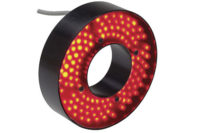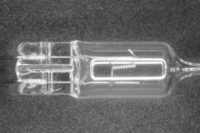Choosing the right inspection system for your application can be a daunting task. For industrial applications three types of inspection systems are generally used. This guide describes these systems, their common applications along with pros and cons.
Stereo Zoom Microscope
The stereo zoom microscope is the most commonly used microscope in industrial applications. A stereo scope generally consists of a main objective lens, two eyepieces for viewing with a magnification range that tend to top out at 200x.
Common applications:
- Multiple types of precision assembly work including but not limited to soldering, medical device manufacturing, and laboratory use.
Pros:
- Larger working distances allow user to work with tools (soldering iron, cutters etc.) under
- the microscope.
- Live 3D view and excellent
- depth of field making precision assembly easier.
- Low first cost.
Cons:
- Image capture and digital
- measurements are not possible.
- Eye fatigue from constant use
- Limited magnification range generally up to 200x
Trinocular Stereo Zoom Microscope Inspection System
This system features a stereo zoom microscope as described above, with an additional third port to support a camera for image capturing. The camera can then be connected to a computer (USB type cameras) or directly to a monitor (VGA, SXGA, HDMI type cameras).
Common Applications:
- Assembly applications that do not require constant 3D image with large depth of field.
- Assembly applications where image capture and measurement may be necessary.
- Quality inspection where some assembly/rework/repair may be necessary.
Pros:
- 3D view visible when working underneath the scope along with additional 2D screen monitor view that helps to reduce eye fatigue. No eyepieces required for this view.
- Image capture and measurement capabilities when paired with a USB/digital camera.
Cons:
- Loss of 3D depth of field when viewing on monitor
- Higher first cost than stereo zoom microscope
- Video Lens Inspection System
Video Lens Inspection System
Systems consist of a single lens paired with an USB/HDMI/Analog camera attached to a monitor or computer. Systems can be built piece by piece or are pre-configured and pre-assembled. Magnification ranges for video inspection systems can go up to 3000x.
Common Applications:
- Quality inspection and documentation
- Performing measurement and other analysis when paired with USB camera
- High magnification applications
- Light assembly work at low magnifications
Pros:
- Versatile systems that can be configured in multiple ways to provide a wide range of magnifications.
- Easy image capture and analysis when paired with USB camera
- Significantly reduces eye fatigue when used in lieu of traditional microscope.
- Priced for almost any budget
Cons:
- 2-D only image that significantly reduces depth of field at higher magnification when compared to a traditional stereo microscope.
- When paired with USB camera image may “lag” when moved.
When considering an inspection system that is right for you, evaluate your specific application needs, budget allocation and comfort levels. Before investing in a system it may be helpful to consult with a supplier specializing in optical instruments and professional tools. Q
Microscopes Meet Additive Manufacturing
Microscopes can evaluate products created via additive manufacturing as well as the powders used to create them.
— By Michelle Bangert
Dutch spectacle maker Hans Janssen and his son Zacharias would be impressed by how far the microscope has come and what it can be used for today.
Unlike some other quality inspection equipment—such as coordinate measuring machines or machine vision systems—the basic idea behind microscopes is something that everyone is likely to understand. Whether you used them to magnify slides for a school science project or have just seen a lot of them in TV crime labs, the devices are well known.
And not only that, they are a big business. According to MarketsandMarkets, the microscopy market is predicted to reach $7.39 billion by 2022. This is up from the $5.30 billion in 2016.
This lines up with Quality’s Spending Survey results released this January. Seventeen percent of the budget for optical inspection and measurement equipment was slated to be spent on microscopes. This is a jump from 2016, when only 12% of this budget was planned for microscopes. Overall, 30% of survey respondents planned to purchase some type of optical inspection and measurement equipment for the 2018 fiscal year.
The industry continues to grow, as microscopes are used in industries such as automotive, aerospace and medical, with a range of applications involving nanotechnology and precision manufacturing. While the technology continues to attract new markets, it has also played a role in one of today’s biggest manufacturing trends: additive manufacturing.
Then and Now
While microscopes are a large industry today, its predecessors have been around as early as the Middle Ages, when a version was introduced to magnify manuscripts. By the end of the 16th century, Hans and Zacharias Janssen were developing a version of a compound microscope. The technology continued to advance from there, with Galileo also developing one of his own.
It may seem that a technology that has been around for so long does not promise a lot of innovations, but both the technology and the applications for it continue to evolve.
Consider the use of microscopes for additive manufacturing. While microscopes have been around for centuries, additive manufacturing has been popular for just decades, and the two technologies together have a lot of potential. The introduction of 3D printing on a large scale has brought new possibilities to the microscope industry.
Additive Analysis
With the rise of additive manufacturing, microscopes can play a starring role in product analysis. Microscopic analysis is essential in quality control in several ways. A microscope would be able to measure particle size distribution; distinguish subtle differences in shape; and detect impurities. They can be used to measure additive manufacturing metal powders, looking at particle size, shape, and composition, as well as inspecting finished parts.
Although the application areas may be new, whenever selecting a microscope, some standard concepts remain. Consider the magnification, resolution, contrast, depth of field, field of view, illumination method, degree of automation and type of image produced.
The enduring power of microscopes indicates that they will continue to be a powerful tool for quality control as time goes on. Regardless of what lies ahead for the manufacturing industry, it seems that there will always be applications that call for seeing things too small to be seen with the naked eye.
Michelle Bangert is the managing editor of Quality Magazine. For more information on microscopes, visit www.qualitymag.com.


